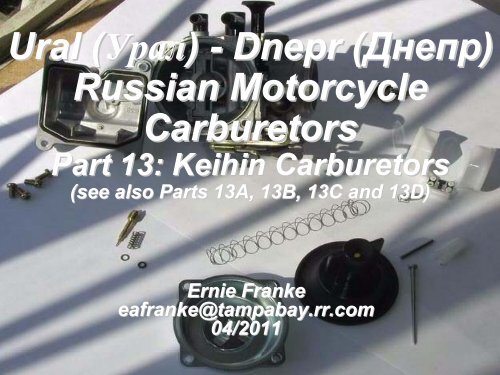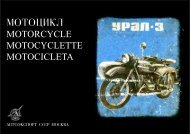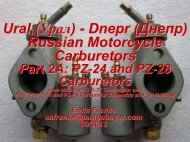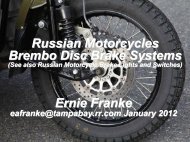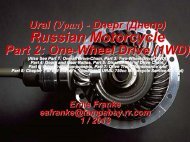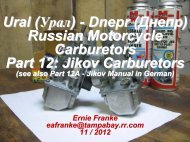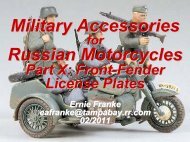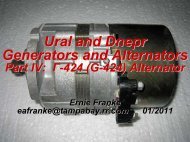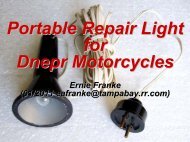Part 13: Keihin Carburetors - Good Karma Productions
Part 13: Keihin Carburetors - Good Karma Productions
Part 13: Keihin Carburetors - Good Karma Productions
You also want an ePaper? Increase the reach of your titles
YUMPU automatically turns print PDFs into web optimized ePapers that Google loves.
Ural (Урал(Урал) - Dnepr (Днепр(Днепр)Russian Motorcycle<strong>Carburetors</strong><strong>Part</strong> <strong>13</strong>: <strong>Keihin</strong> <strong>Carburetors</strong>(see also <strong>Part</strong>s <strong>13</strong>A, <strong>13</strong>B, <strong>13</strong>C and <strong>13</strong>D)Ernie Frankeeafranke@tampabay.rr.com04/2011
K-68 to CVK32 <strong>Keihin</strong> Carburetor Transition(http://www.cossackmotorcycles.com/dnepr.html)•K-68 Runs a Little Rich Most of the Time•Requires Frequent Adjustment to Stay Perfectly in Tune•Looks Similar to the K-68 Fitted to Late 650cc Urals•They’re Not the Same•Don't go Swapping Them from One to AnotherK-68<strong>Keihin</strong>•Ural Changed to Dual <strong>Keihin</strong> Seiki for US Import Models•Fitted to Pass Stringent Emission Regulations (EPA)•Current <strong>Carburetors</strong> for 650/750cc Motorcycles•Generally a <strong>Good</strong> Carb, but Needs Re-Jetting to AvoidOverheating at High Engine Loads•Must Be Kept Clean and Jets Need Regular Blowing Out,Especially the Ones that Can Be Seen in the Carb Throatwhen Air Filter Pipes Are RemovedThe common carburetors found on 750cc Ural motorbikeswere the K-68K68’s.Prompted by the need to meet the stringent EPArequirements for imports to the US, Ural chose the Mikuni,which was later replaced by the CVK32 <strong>Keihin</strong>,which appeared in 2000, and has remained steady today.
Russian Carburetor Time-Line(04/2011)K-37 (M-72)K-37 (M-72, M-72K, M-72M,M-72H, K-750)K-38 (M-61, M-62, M-63)K-301Б (M-63, M-66, K-650/MT-9)K-301В (MT-10)K-301Г (M-63, M-67, M-67.36)K-301Д (MT-10,MT-10.36, MB-650M,K-650/MT-8/MT-9)K-37 K-37AK-38K-3011940 1945 1950 1955196019651970K-63/K-65 (MT-11, MT-16)CVK32 <strong>Keihin</strong>(8.103, 8.107)K-302 K-62 K-63/K-65K-681975K-302 (MT-11, MT-12, IMZ-8.103)K-62 (MT-16, MT-12, MB-650)28 mm Mikuni (8.103)K-68 (MB-650)UralsLast of the Dneprs1975 1980 1985 199019952000 20052010The 28 mm Mukuni was introduced in 1994 to meet EPA requirementson imported Urals, later replaced by the 32 mm <strong>Keihin</strong>.
CVK32 <strong>Keihin</strong> Carburetor•Bleed Type Carburetor•Variable Venturi Controlled by Constant Velocity (CV)–Also Known as Constant Depression or Constant Vacuum•CV is Next Best Thing to Electronic Fuel Injection–Feeds Precise Amount of Mixture to Smooth-Out Throttle Response–Reduces Pollution and Stretch Fuel Budget and Gas-Tank Range•“32” Represents 32 mm Venturi Exit Diameter•Butterfly Valve Instead of Round-Slide or Flat-Slide Throttle Valve–Evidenced by the Rotary Movement on the Side–Throttle Cable Connected to Butterfly Valve–Varies Volume thru Venturi•Nominal Jets for 650 cc–Main Jet: 118–Nozzle Idling: 38–Concentrator Nozzle (start): 65•Please See <strong>Part</strong> <strong>13</strong>C for Re-Jetting of Carb–2002 CMSI 750 cc: 38 (some had 40) and 125–2003 and early 2004 IMWA 750cc: 38 and 118–Late 2004 bikes: 38 and 125–2005 thru 2007: 38 and 125 (Ducati Ignition starting with 2007 bikes)The <strong>Keihin</strong> has a butterfly valve, much likeis commonly found in automobiles.
Variable Venturi - Getting Sucked In (Redondo Ron, 1998,(Redondo Ron, 1998, www.gadgetjqgadgetjq.com)•Venturi Is a Tube with Convex Taper (one end wider than the other)•As Air Enters Wider End, It's Squeezed into Narrower Section of Tube,Lowering Air's Pressure•Area of Lowest Pressure Is Just Past the Narrowest Point–Lowest Pressure Point Called the Depression•Bernoulli's Principle States That This Lowered Pressure, or ComparativeVacuum Is Separate from Engine Vacuum•Variable Venturi Varies the Venturi Diameter at the Depression byRaising or Lowering an Obstruction•This obstruction is Called a Slide•On a CV the Slide is Called a Diaphragm Valve(Butterfly Valvefor <strong>Keihin</strong>)
CVK32 <strong>Keihin</strong> Carburetor'IMZ-8.128-15001Carburetor <strong>Keihin</strong>Cap'93500040081H'12908802000Pan ScrewCoil spring'14028462200Vacuum Piston Comp.'12298007000Spring SeatSlideSpring'N425-6NE00'N4<strong>13</strong>03C00Jet NeedleNeedle Jet HolderPilot JetNeedle JetFloat ValveAir TubeNeedle Holder'9910<strong>13</strong>931220'9910<strong>13</strong>931250'N42425B38Main Jet 122Main Jet 125Slow Jet 38Idle Mixture NeedleMain JetNeedle'N42425B40'16155ZG8L100'N42431065Slow Jet 40Float Valve Comp.Starter Jet 65FloatsFloat PinSlideDiaphragm'10528292100'09018146000'11988102002Float ValveFloat Body GasketDrain Screw'93500040141HPan ScrewFloat Body Gasket'N44602C00CO2 Adjust Screw'IMZ-8.1037-15157Cap for Carburetor BreatherFloat Chamber
32CVK Components38 jet = 0.38mm or 0.0149 in.45 jet = 0.45mm or 0.0177 in.125 jet = 1.25mm or 0.0492 in.1. Slide Spring2. Slide Diaphragm3. Vacuum Slide4. Vacuum Port5. Needle Jet6. Main Air JetMain Jet7. Main Jet8. Pilot (Slow) Jet9. Idle Mixture Adjustment Screw10. Throttle PlatePilot (Slow) Jet
Round-Slide vs. Flat-Slide vs. Butterfly Throttle Valves•Round-Slide Throttle Valve–K-37, PZ-28, K-38–Kaptex VDC-RAM–K-68–Mikuni VM-28–Jikov 2928•Flat-Slide Throttle Valve–K-301 / K-302–K-62 / K-63 / K-65•Butterfly Throttle Valve–<strong>Keihin</strong> CVK32One term describing carburetors is round-slide,flat-slide or butterfly throttle valves.
Flange-Mount vs. Spigot-Mount•Flange-Mount–Bolts Directly on Cylinder Head or Adapter–K-37, PZ-28, K-38,–K-301 / K-302–K-62 / K-63 / K-65 / K-68–Kaptex VDC-RAM•Spigot-Mount–Rubber Compliant Mount to Cylinder Head–Mikuni VM-28–Jikov 2928CE–<strong>Keihin</strong> CVK32Another term describing carburetors isflange-mount or spigot-mount.
<strong>Keihin</strong> Carburetor (oppozit.ru)from Branch PipeDrain HoleFuel InletEnrichenerGasket between UpperChamber and Float SystemThe 32CVK is a common type for the Japanese, the differencesin models are usually in the diameter of the diffuser and nozzles,although there are also minor structural differences dependingon volume, design and model year.
<strong>Keihin</strong> CarburetorCarburetor (oppozit.ru)Throttle Cable BracketVacuum Nipplefrom Branch PipeIdle Adjust Screwto EngineDrain ScrewThe idle adjust screw sets the speed for each carburetor at rest.The drain screw is periodically backed out to rid water andother contaminants.
Bottom View with Float System Removed (oppozit.ru)Starter Jetto EnginePilot (idle) Mixture ScrewMain JetPilot JetFloat Valve Seatfrom Branch PipeRemoving the 4 float bowl screws and the float assembly revealsthe starter jet, main jet and pilot jet.
Float System (oppozit.ru)Before bending anything,visually inspect the rubber tipon the float valve and spraysome carb cleaner andcompressed air in the valveseat, to make sure nothing isblocking it open.FloatFloat Valve and Float PinThe float is hinged on a pin in the float boss, rising and falling withfuel level in the float bowl. The small metal tang integrated in theplastic float supports the float valve (float needle). As fuel in the floatbowl rises, the float valve is pushed into the valve seat, until it's highenough to shut off the fuel to the bowl. As the level in the bowl drops,lowering the float, float valve pulls from it's seat, and fills again.
Float Height (oppozit.ru)Float Height: 0.5mm ±0.1mm(only about 0.08" variance)to Enginefrom Branch PipeThe float level is the first thing that needs to be checked when tuningyour carb. If the level is too high, it can cause a rich condition,too low and it can cause a lean condition. If it's not set correctly,any other adjustments you make may have to be redone.
Idle Mixture Needle of <strong>Keihin</strong> Carburetor (oppozit.ru)Idle MixtureNeedleMixture Needle and Seat Should Be Clean.Pay Close Attention to the Two Washers.Idle Mixture Screw AdjustmentIs Underneath the CarbThe idle mixture-adjustment screw is turned very gently CWuntil you just meet resistance, any further and you will damagethe needle. Factory setting is 1-1/211/2 turns CCW from seated.
<strong>Keihin</strong> Carburetor (oppozit.ru)Pilot JetsCoasting Enrichener JetsPay attention to the opening of the idle channel, when operatinga motorcycle with a faulty engine. <strong>Part</strong> of the holescould be clogged with soot, emissions from the cylinder.
Slide DiaphragmCoasting Enrichener (oppozitoppozit.ru)Cover (Cap)Spring Seat (needle holder)Slide SpringNeedleYou're blasting down the trail and you see a hairpin coming up, so you let off the throttle,which closes the butterfly valve. Your 700 lb Ural is still rolling with inertia, keeping theengine rev’s high. The engine can't get the mixture it's trying to suck in because thebutterfly valve is closed, blocking air flow. To compensate for this there's an air jet inthe lower diaphragm chamber that transfers ambient pressure to one side of thecoasting enrichener's spring-loaded cut-off valve. The excess vacuum in front of thebutterfly valve is transferred to a drilling that leads to the other side of the cut-off valve.This sucks it open, allowing the pilot jet to feed more fuel to the engine preventingan overly lean condition.
<strong>Keihin</strong> Carburetor (oppozit.ru)When re-building the carb, check that the needle holder is mountedevenly on the needle. Spread the diaphragm, and gently coverwith a lid, do not over tighten the screws to avoiddamaging the sealing skirting of the diaphragm.
2003 Patrol (32mm CVK <strong>Keihin</strong> Seike <strong>Carburetors</strong>)Branch PipeCompliantGasketEnrichener(a.k.a. Choke)CarburetorNever use a metal adapter between the carburetor and cylinder head.
2000 Ural Carburetor Troubleshooting ChartPROBLEMHardstartingPoor idleor stallingPOSSIBLE CAUSEIncorrect use of enrichenerClogged fuel filterClogged low speed fuel jetsFloat stuckFloat damaged or leakingIntake air leakIgnition problemLow cylinder compressionIdle speed adjustments are unequal(twin carburetor models and multicarburetormodels using individualthrottle stop adjustments)Clogged idle and low speed air bleedCORRECTIONSCorrect use of enrichenerClean filterDisassemble carburetor and chemically cleanRemove float bowl, check float operation andcorrect or replaceReplace floatCheck carburetor mounting flanges for air leaksRepair, replace or adjust as necessaryRepair, replace or adjust as necessaryEqualize throttle stop settingsDisassemble carburetor and chemically clean
Pilot System (Redondo Ron, 1998, www.gadgetjq.com)•Pilot System Supply the Air/Fuel Mixture at Idle–Continues to Supply Fuel throughout EntireThrottle Range–After about 1/8 Throttle, MAIN SYSTEM Cuts-In toSupply an Increasing Percentage of Total MixtureUp to Full Throttle•When You Set the Idle with Big Screw on RightSide of the Carb, What You're Doing Is Coveringor Uncovering One or More of the Four SmallHoles that Are Drilled into the Venturi (leading tothe pilot jet), Just under the Butterfly Valve, andLetting More or Less Air Pass the Butterfly•When You Adjust the Pilot Screw (under thecarb), You Are Varying the Amount of Air Pre-Mixing with the Fuel before It Enters the VenturiAt 6 o'clock in the mouth of thecarb you can see the end of theidle mixture needle poking up.
Main System (Redondo Ron, 1998, www.gadgetjq.com)• Top Chamber Separated from Bottom Chamber byRubber Diaphragm• Bottom Chamber Is Open to Atmospheric Pressure• When Vacuum in the Top Chamber Rises Sufficiently,the Constant Ambient Pressure of the Lower ChamberHelps the Diaphragm Valve Overcome the DownwardForce of the Diaphragm Spring, and It Rises from theVenturi• As the Diaphragm Valve Is Raised from the VenturiDepression (lowest pressure area), the Needle isPulled Further Out of the Needle Jet, Exposing aThinner Portion of the Needle Taper, Which AllowsEven More Fuel to Rise into the Venturi to Meet theIncreased Engine Demand
32 CVK Carburetor ("The Unofficial Ural 750cc Service Manual,“ www.myural.com/)Front-View, Compliance Fitting SideLeft-Side ViewBranch Tubing or Intake SideRight-Side, Idle Setting ScrewTop-View Diaphragm CapBottom-View, Bowl Drain
<strong>Keihin</strong> L22 AA <strong>Keihin</strong> Carburetor for 750 cc
Diagnosing Issues on my Ural: Air/Fuel Mixture and Carburetor SynchronizationOctober 10th, 2009, Domingo Chang, Colorado Motorcycle Travel Examiner• Set Fuel Mixture Screw Located at Bottom of Each Carburetor's Float Bowl• Turn 2.5 turns from Seat (starting point)–Screw Fuel Mixture Screw Clockwise till It Stops–Don't Force It, Be Gentle and Smoothly "seat it“–Correct Number of Turns is 1-1/2 turns from Seated• Adjust Idle Speed Using Idle Set Screws to Control Amount of Air Drawn at idleinto Carburetor's Venturi Chamber–Loosen Throttle Set Screws (red circled item below) and Take Throttle CablesOut of the Equation–Don't Want Tension on Butterfly Lever when Turning Throttle Grip!–Take Cable Out of Channel and Let Hang Loose but Still Connected to ButterflyLeversFuel Mixture Screw
Diagnosing Issues on my Ural: Air/Fuel Mixture and Carburetor SynchronizationOctober 10th, 2009, Domingo Chang, Colorado Motorcycle Travel Examiner•Remove Black Rubber Caps on <strong>Carburetors</strong> which Seal the VacuumNipples (red rectangled item below)•Use Home-Brew Manometer•Hook Up to Vacuum Nipples on Each Carburetor (see below)–Left Vacuum Hose Goes on Left Side of Engine, Right Hose to Right Side•Start the Engine and Note the Levels which Reveal How Much VacuumEach Carburetor Is Pulling or Generating•The Side with the Higher Fluid Level Is Pulling the Most VacuumClose-up of manometer's tubingattaches to the carburetorVacuum Nipple
Diagnosing Issues on my Ural: Air/Fuel Mixture and Carburetor SynchronizationOctober 10th, 2009, Domingo Chang, Colorado Motorcycle Travel Examiner•Slowly (in small increments) Adjust Each Idle Set Screw until FluidLevels on Manometer for Each Carburetor Hold Even•Be Patient, Allowing a Couple of Seconds for Changes to Take Effect(See yellow circled area below)•Once Set Steady at Idle, Rev Engine to 2000-3000 rpm– Levels Should Remain Steady– If So, Successfully Synchronized <strong>Carburetors</strong>!– Turn Off Engine•Place Throttle Cables Back into Play, Securing Set Screws So That WhenYou Twist the Throttle, It Turns Butterfly Levers on Both <strong>Carburetors</strong> atSame Time and Angle (see red rectangled area below)idle set screw
Diagnosing Issues on my Ural: Air/Fuel Mixture and Carburetor SynchronizationOctober 10th, 2009, Domingo Chang, Colorado Motorcycle Travel Examiner•Ideal Condition: Light Brown or “Caramel" Color•Black Soot Means Air / Fuel Mixture Running Too Rich or Too Much FuelIdeal Condition: Light Brown or “Caramel"Too Rich Condition: Black Soot
Diagnosing Issues on my Ural: Air/Fuel Mixture and Fuel DeliveryOctober 10th, 2009, Domingo Chang, Colorado Motorcycle Travel Examiner• Determine <strong>Good</strong> Steady Fuel Delivery to <strong>Carburetors</strong>–Check for <strong>Good</strong> Steady Flow on Both Lines from Y-Junction under Petcock–Check In-Line Fuel Filters for Debris or Obstructions–Drain Some Fuel from Each Carb by Loosening Screw on Bottom of Float BowlChamber using 3mm Allen Wrench–Check Fuel for Water (it'll settle to the bottom) and Contamination/Debris• Remove Float Bowls by Removing the 4 Screws Used by Ural and ExamineContents of Bowl for Contamination and Water–Replace Easily-Stripped Screws, with Allen-Headed Stainless-Steel Screws• Blow-Out Any “Gunk" in the Jets within Carburetor's Fuel Paths–Best Way Is to Take <strong>Carburetors</strong> Apart and Do a Thorough Cleaning of the Jetsand Liberal Use of Carburetor Cleaning Spray while Examining theComponents.• Following Procedure is “Quick and Dirty" Way of Clearing Fuel Path, but Not aLong-Term Solution–Do This with Little or No Fuel in Float Bowls• Some Fuel Works Better as It Acts as a Hydraulic Force thru the Carburetor Jets–Plastic Elbow Piece (vent mechanism) on Side of a <strong>Keihin</strong> (see light blue circle)–When You Blow Air Through, It Will Exit This Vent!
Stainless-Steel Steel Allen-Head Screw Upgrade Kit forTop Cover and Bowl Chamber of <strong>Keihin</strong> Carbs8 Screws for Top Cover8 Screws for Bowl ChamberHelpful upgrade kits to allen-head, stainless-steel screwsare readily available from HeindlEngineeringand Holopaw Gene.
Diagnosing Issues on my Ural: Fuel Delivery / Fuel PathOctober 10th, 2009, Domingo Chang, Colorado Motorcycle Travel Examiner• Blowing Out the Fuel Path–Use Manual Air Pump or Air Compressor Set for 20 PSI max, with Cone Adapter toSnugly Fit into Fuel Line's Opening–Ensure Fuel Petcock Is Closed• If Petcock Isn’t Closed, Fuel Will Come Out the Lines–Disconnect Fuel Filter (red circle) from Each Carburetor• Leave Short-Length Fuel Line (blue arrow) which Connects to Carburetor Itself• Connect (using a plastic cone-shaped adapter) Air Hose to Short Fuel Line, Holding ItTight to Get a Snug Fit• Place Wad of Shop Towel Paper against Opening of Carburetor's Vent and Blow TwoQuick Sub-Second Blasts of Air into Fuel Line• Most Fuel Caught by Shop Towel Wad of Paper–Do Both <strong>Carburetors</strong> in Same Manner–After Loosening the Gas Cap, Blow Air thru Length of Fuel Line which Was Connected toFuel Petcock• Ensure End of Fuel Line with Compressor Is HIGHER than the Fuel Petcock WhenOpen the Petcock to Open the Fuel Path into the Gas Tank!–Hearing Air within the Tank Gives Confidence of No Debris in That Portion of Fuel Path• Button Things Up and Go for a Test Ride
Carburetor Enricheners (www.gadgetjq.com)• Carburetor Enricheners Provide Extra Fuel to the Fuel-Air Mixture,Allowing a Cold Engine to Start and Run until Warmed-Up Sufficientlyto Allow Normal Operation• Pulling the Enrichener Retracts a Plunger that Opens a TubeConnected to the Starter Jet, Allowing Additional Fuel to Enter Venturijust below Vacuum Hose Nipple• It Supplements the Pilot System at Start-Up• Use Caution When Using Enricheners, as They Can Easily CauseEngine to Flood or to Foul Spark PlugsEnrichener On(Starting)Enrichener OffThe enrichener is referred to as the choke. But that's a misnomer. When youapply the choke lever, what you're doing is retracting a plunger that opens atube connected to the starter jet, allowing additional fuel to enter the venturijust below the vacuum hose nipple, supplementing the pilot system at start up.
2000-2003 2003 Patrol (<strong>Keihin</strong>) and Gear-UpEnricheners• <strong>Keihin</strong> Carbs Do Not Have a Choke, but Use a Mixture Enrichment Circuit, or Enrichener• Enricheners Work by Opening a Secondary Fuel Circuit below the Throttle Valve–Circuit Works Like Idle Circuit, Supplying Extra Fuel when Throttle Is Closed• First Enricheners Used on Urals Imported to U.S. to Satisfy EPA–32mm CVK <strong>Keihin</strong> (2000-present)• When Engine Is Cool or Cold and Ambient Temp between 40°F-60°F (5°C-15°C), Pull-OutBoth Enricheners to Start• As Soon as Engine Starts, Immediately Push-In Enricheners• Run Engine at Moderate Speed for 30-60 seconds• If Engine Starts to Die, Blip the Twist Grip Throttle (rapidly twist part way towards fullthrottle and then back off) to Keep Engine Running• After 1 to 3 minutes, Depending on Ambient Temp, Engine should Run Smoothly without“blipping” the Throttle• If Engine Is Cold and Ambient Temperature Is below 40°F (5°C)–Give Engine 5-10 (depending on how cold it is) Priming Kicks with Ignition Off• Gets Some Oil Circulated to Key Internal <strong>Part</strong>s–Engage Enricheners on Both <strong>Carburetors</strong>–Engine Should Fire, Depending on Temp (for example, when the ambient temperature is0°F, it typically takes about 5-10 rotations to start Engine)–When Engine Starts, Disengage Both Enricheners (after a few seconds)• Back-Off on Enricheners as soon as Engine Sustains Itself without Stalling• Since the Ural is Carbureted Air-Cooled Engine, Plugs Will Foul Quickly (as soon as oneminute) If Engine Mixture Too Rich• If One Plug Fouls and Other Doesn’t, Engine Will Run Unevenly and May Cause InternalDamage• When Engine Is Hot, Do Not Enrichen <strong>Carburetors</strong> (Risks Flooding Engine)If the ambient temp is high (60°F (15°C) or above),try starting the engine without pulling the carburetor enricheners.


